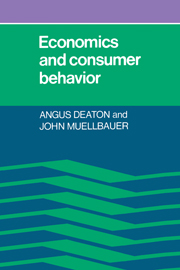Book contents
- Frontmatter
- Contents
- List of tables and figures
- Preface
- PART ONE CONSUMER DEMAND ANALYSIS
- PART TWO SEPARABILITY AND AGGREGATION
- PART THREE WELFARE AND CONSUMER BEHAVIOR
- PART FOUR EXTENSIONS AND APPLICATIONS
- 10 The quality of goods and household production theory
- 11 Labor supply
- 12 The consumption function and intertemporal choice
- 13 The demand for durable goods
- 14 Choice under uncertainty
- References
- List of notation
- Name index
- Subject index
11 - Labor supply
Published online by Cambridge University Press: 05 June 2012
- Frontmatter
- Contents
- List of tables and figures
- Preface
- PART ONE CONSUMER DEMAND ANALYSIS
- PART TWO SEPARABILITY AND AGGREGATION
- PART THREE WELFARE AND CONSUMER BEHAVIOR
- PART FOUR EXTENSIONS AND APPLICATIONS
- 10 The quality of goods and household production theory
- 11 Labor supply
- 12 The consumption function and intertemporal choice
- 13 The demand for durable goods
- 14 Choice under uncertainty
- References
- List of notation
- Name index
- Subject index
Summary
No part of economics is more contentious and more interconnected with the rest of the subject than is labor economics. We shall here attempt to separate the analysis of labor supply from labor economics as a whole, but it is inevitable that, to some extent, we shall be drawn into wider issues. One aspect of the contentiousness of the subject is the range of different approaches to it, from the institutionalists, on the one hand, to those who apply a narrow version of the neoclassical paradigm, on the other. Our approach is analytical, but we think not narrow and, as throughout the book, our aim is to formulate models relevant for good empirical work.
The chapter is divided into three sections. The first extends Chapter 4's discussion of the basic neoclassical model of labor supply to deal with the case where the individual chooses not to work at all. The choice between working and not working is referred to as the participation decision, and in §11.1, we show how it can be analyzed in terms of the divergence between the actual and an appropriately defined “shadow” wage rate. We also discuss the implications of this theoretical analysis for econometric studies of participation rates and of the labor supply of those who do work. Section 11.2 considers the effects of abandoning the linear budget constraint of the neoclassical model and takes a more realistic view of the constraints faced by households.
- Type
- Chapter
- Information
- Economics and Consumer Behavior , pp. 273 - 308Publisher: Cambridge University PressPrint publication year: 1980



